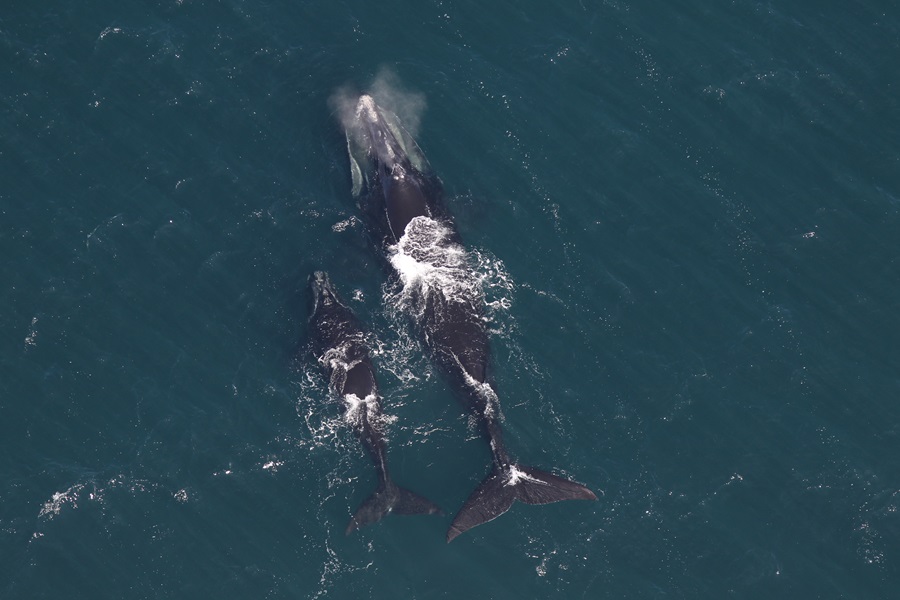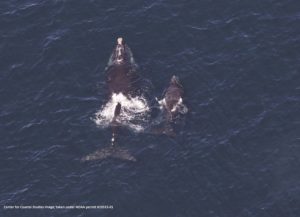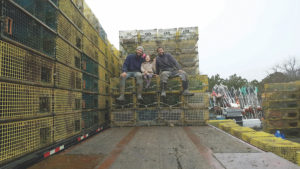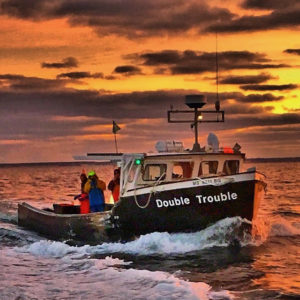[PROVINCETOWN — North Atlantic right whales, critically endangered with a population of only around 370, move widely around our ocean. They have traditionally ranged from below Cape Canaveral, Fla., where they calve in winter, to New England and into Canada following the summer food supply. But their distribution has been shifting as the location of plankton, their key food, is altered by climate change.
In January, a study published in Endangered Species Research found that right whales’ main food source is declining across its range, with less nutritious food sources taking its place.
While this might suggest that Cape Cod Bay, which hosts a large proportion of the world’s right whales every spring, could lose its whales as they shift to new foraging grounds, that is not happening yet, according to researchers at the Center for Coastal Studies.
The number of right whales visiting Cape Cod Bay each year has been steady and has even increased slightly, and its plankton resource has remained steady, said Charles “Stormy” Mayo, scientist emeritus with the Coastal Studies Right Whale Ecology Program. But of course, he said, this can’t continue forever as our waters keep warming.

Following the Food Supply
Right whales feed chiefly on Calanus finmarchicus, a chunky, nutritious species of the zooplankton known as copepods. Scientists following changes in whales’ behavior have long paid attention to these copepods’ range.
In September 2021, a group of scientists led by Erin Meyer-Gutbrod of the University of South Carolina reported in Oceanography that plankton community changes had begun forcing right whales to abandon their traditional summer feeding areas in the Bay of Fundy as early as 2010. They now primarily use the Gulf of St. Lawrence to feed in the summer.
The Endangered Species findings reported in January were based on research led by Taylor Evans, then a postdoc at the State University of New York at Stony Brook studying marine biology. Evans looked at “plankton tows” done by the National Oceanic and Atmospheric Administration between 1980 and 2019 to see how the plankton communities were changing in the Northeast. What she found was that C. finmarchicus had broadly declined across its range — particularly in the Bay of Fundy.
Evans told the Independent that C. finmarchicus is a cold-water species, and its decline is tied to increases in water temperature. In its place, other warmer-water copepod species, such as C. typicus, which have 10 times less nutrition than C. finmarchicus, are increasing. When it comes to nutrition, she said, “it would take a wild and unthinkable amount of them to make up for what we’re losing in C. finmarchicus.”
Cape Cod Bay seems to be somewhat shielded from these declines. According to Mayo, the bay’s C. finmarchicus densities have not changed, even as declines happen elsewhere in the Gulf of Maine. “Though we are at the bottom of a conveyor belt that seems to be changing, we have what seems to be a stable system,” he said.
Evans agreed. “I don’t see Cape Cod Bay being less important anytime soon,” she said. Indeed, as declines happen elsewhere, “it could even become more important.”
Why Cape Cod Bay is so consistently hospitable for right whales is difficult to say with certainty, but according to Daniel Palacios, director of the Coastal Studies Right Whale Ecology Program, scientists think that it acts as a “cul-de-sac” — the current flows in from the north with nutrient-rich water, which leads to nutrient buildup in the bay. Additionally, because the bay is protected from the rest of the Atlantic Ocean, this concentration isn’t quickly washed away, he said.
In recent years, Mayo said, more right whales than ever have visited Cape Cod Bay. A given year will host between 170 and 312 individuals — up to 75 percent of the world population of these whales. It seems to be a particularly important site for mothers and calves, Mayo said.
“Right now, right whales are numerous in Cape Cod Bay,” he said. “That’s an indication that at the base level, which is the quality of the ecosystem, they’ve said, ‘Yeah, this is pretty good.’ ”
On Jeffreys Ledge
During a series of aerial surveys conducted by the New England Aquarium in January, scientists documented over 75 individual right whales congregating around Jeffreys Ledge off the coast of New Hampshire, representing more than 20 percent of the total population.
While the sighting was noteworthy, Palacios said that it wasn’t a first. Jeffreys Ledge was considered a reliable right whale feeding site in the 1980s and ’90s, though it had become less important in recent decades. “These sorts of decadal shifts are not uncommon in baleen whales,” Palacios said. He also noted that the difficulties involved with surveying for right whales by air — like bad weather — mean that incidents like this may have happened before and just weren’t detected. “It might have been the right people out at the right time to detect this aggregation,” he said.
Jeffreys Ledge is also an ephemeral feeding site, Palacios said. It has steep underwater walls that can channel nutrient-rich deep water upward, which causes plankton blooms — but only if the current is sufficiently intense and flowing the right way. That makes it, like so many other sites, an inconsistent supplier of food. “The one that has remained pretty consistent has been Cape Cod Bay,” he said.
One Year at a Time
But while Cape Cod Bay is holding steady for now, there is no reason to believe the collapse of these plankton communities will not happen one day. “I think that, eventually, Cape Cod Bay will go through dramatic changes,” Mayo said. “It’s not completely insulated from the changes in the larger Gulf of Maine.”
Palacios agreed. “Over the course of 50 or 100 years, gradually things will continue warming to a degree that the water will be too warm for phytoplankton,” he said. “Therefore, yes, the whales may stop coming here.”
Mayo said that he has tuned his expectations accordingly. Talking with staff, he said, he prods them to consider the question of whether whales will return to Cape Cod.
“I’ve always said, ‘We’ll see if they come back; I don’t think they’re going to,’ ” he said. “But I said it this year, and they came back.”



